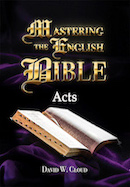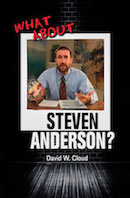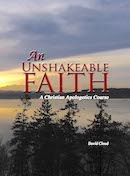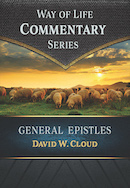866-295-4143, fbns@wayoflife.org
“Although Erasmus published a fourth and fifth edition, we need say no more about them here. Erasmus’s Greek Testament stands in line behind the King James Version; yet it rests upon a half dozen minuscule manuscripts, none of which is earlier than the tenth century. ... THE TEXTUAL BASIS OF THE TR IS A SMALL NUMBER OF HAPHAZARDLY AND RELATIVELY LATE MINUSCULE MANUSCRIPTS” (D.A. Carson, The King James Version Debate, Baker Book House, 1979, pp. 35-36).
Another example of this error is found in the book The Bible Version Debate: The Perspective of Central Baptist Theological Seminary (1997). Chapter four is “Defining the Terms” by W. Edward Glenny, professor of New Testament at Central --
“… the TR is only based on seven late manuscripts” (Glenny, p. 51).
This incredibly erroneous statement has been repeated so frequently by textual critics and modern version defenders that it is commonly accepted as truth. While it is not exactly surprising to see New Evangelicals like D.A. Carson fall for such things, we have seen that some fundamental Baptists are repeating the same tired errors. If scholarly fundamental Baptists of our day would spend at least as much time studying the writings of Bible-believing textual scholars such as John Burgon, Edward Miller, and E. F. Hills, who believe in infallible inspiration and divine preservation, as they do studying the writings of Modernists and New Evangelicals such as Bruce Metzger, F.F. Bruce, and Kurt Aland, who deny both inspiration and preservation, they might not be so quick to pass along fallacies to unsuspecting readers.
Be that as it will, it is not difficult to dispel the myth that the Received Greek Text underlying the King James Bible and other Reformation Bibles is merely “based on seven late manuscripts.” It is true that Erasmus had in his actual possession only a few Greek manuscripts when he composed the first edition of his Greek New Testament, but he had examined a large number of other manuscripts, both Latin and Greek, and he had compared these with many ancient Bible translations and with a large number of quotations from ancient church leaders. He also was aware of the alternative readings contained in manuscripts such as the Vaticanus and Codex D. Thus he was in a position to know that those few manuscripts he had at hand represented the witness of vast numbers of other manuscripts. The fact is that the Received Text underlying the esteemed and mightily used Reformation Bibles is represented in the majority of existing Greek manuscripts, quotations from ancient church leaders, and ancient Bible translations. This is why the Received Text has commonly been called the “majority text” (though that term has been usurped in recent years by the Hodges-Farstad-Thomas Nelson Greek New Testament of 1982). Textual authorities admit that of the more than 5,200 existing Greek manuscripts, 99% contain the common traditional ecclesiastical or Received Text. Thus, on the very face of the evidence, it is nonsense to say that the Received Text is “is only based on seven late manuscripts.”
THE TESTIMONY OF J.H. MERLE D’AUBIGNE DISPELS THIS MYTH
The following quotation from historian J. H. Merle D’Aubigne demonstrates that Erasmus had access to more textual evidence than his modern detractors admit:
“Nothing was more important at the dawn of the Reformation than the publication of the Testament of Jesus Christ in the original language. Never had Erasmus worked so carefully. ‘If I told what sweat it cost me, no one would believe me.’ HE HAD COLLATED MANY GREEK MSS. of the New Testament, and WAS SURROUNDED BY ALL THE COMMENTARIES AND TRANSLATIONS, by the writings of Origen, Cyprian, Ambrose, Basil, Chrysostom, Cyril, Jerome, and Augustine. ... HE HAD INVESTIGATED THE TEXTS ACCORDING TO THE PRINCIPLES OF SACRED CRITICISM. When a knowledge of Hebrew was necessary, he had consulted Capito, and more particularly Ecolampadius. Nothing without Theseus, said he of the latter, making use of a Greek proverb” (J.H. Merle D’Aubigne, History of the Reformation of the Sixteenth Century, New York: Hurst & Company, 1835, Vol. 5, p. 157).
The popular notion that Erasmus and other 16th-century editors of the Greek New Testament worked with paltry resources is simply nonsense. The notes that Erasmus placed in his editions of the Greek New Testament prove that he was informed of the variant readings that have found their way into the modern translations since 1881. Even though Erasmus did not have access to all of the manuscripts translators can use today, there can be no doubt that he did have access to the variant readings in other ways.
“Through his study of the writings of Jerome and other Church Fathers Erasmus became very well informed concerning the variant readings of the New Testament text. Indeed almost all the important variant readings known to scholars today were already known to Erasmus more than 460 years ago and discussed in the notes (previously prepared) which he placed after the text in his editions of the Greek New Testament. Here, for example, Erasmus dealt with such problem passages as the conclusion of the Lord’s Prayer (Matt. 6:13), the interview of the rich young man with Jesus (Matt. 19:17-22), the ending of Mark (Mark 16:9-20), the angelic song (Luke 2:14), the angel, agony, and bloody seat omitted (Luke 22:43-44), the woman taken in adultery (John 7:53-8:11), and the mystery of godliness (1 Tim. 3:16)” (Dr. Edward F. Hills, The King James Version Defended, 1956, 1979, pp. 198-199).
Not only did Erasmus consult many Greek and Latin manuscripts and ancient Bible translations to determine the proper text, he examined quotations from ancient Christian writings.
“Erasmus uses the Fathers of the Church as independent witnesses for the early text of the Vulgate. In his dedicatory letter to the pope he mentions that the special care due to the sacred writings caused him not only to compare ‘the oldest and most correct manuscripts’ but also to ‘run through all the writings of the old theologians and to trace from their quotations and expositions what each one of them had read and changed’” (W. Schwarz, Principles and Problems of Biblical Translation, p. 145).
We do not assign any degree of perfection to Erasmus. He had serious faults, to be sure (though more often than not modern version defenders caricature him falsely). It is a fact that Erasmus was diligent in researching the history of the transmission of the Scriptures and that he had sufficient resources for the task. The publication of the first printed Greek New Testament was in no wise the hasty, haphazard, careless thing that today’s textual critics would have us believe. (We say much more about Erasmus and his role in the publication of the first printed Greek New Testament in the book Myths about the King James Bible.)
THE TESTIMONY OF BISHOP ELLICOTT DISPELS THIS MYTH
As for the Received Text being based on “seven late manuscripts,” consider further the testimony of Bishop Ellicott, the chairman of the committee that produced the English Revised Version of 1881 (the committee also included Westcott and Hort), the predecessor of all modern versions:
“THE MANUSCRIPTS WHICH ERASMUS USED DIFFER, FOR THE MOST PART, ONLY IN SMALL AND INSIGNIFICANT DETAILS, FROM THE GREAT BULK OF THE CURSIVE MSS. The general character of their text is the same. By this observation the pedigree of the Received Text is carried up beyond the individual manuscripts used by Erasmus ... That pedigree stretches back to remote antiquity. THE FIRST ANCESTOR OF THE RECEIVED TEXT WAS AT LEAST CONTEMPORARY WITH THE OLDEST OF OUR EXTANT MSS, IF NOT OLDER THAN ANY ONE OF THEM” (Ellicott, The Revisers and the Greek Text of the N.T. by two members of the N.T. Company, pp. 11-12).
Dr. Ellicott was familiar with all of the textual scholarship of his day, and he had no hesitation whatsoever to say that the Received Text is based upon textual authority which is at least as old as that upon which the Westcott-Hort text rested. Dr. Ellicott was saying that the textual authority underlying the Received Text is at least as old as the famed Sinaiticus and Vaticanus manuscripts.
THE TESTIMONY OF THE TRINITARIAN BIBLE SOCIETY DISPELS THIS MYTH
The Trinitarian Bible Society (TBS) of London, England, puts the matter into a perspective that many modern version defenders seem to try their best to ignore. The TBS was formed from a conflict within the British and Foreign Bible Society (BFBS) over the doctrine of the Trinity and the deity of Jesus Christ. The BFBS, which was organized in 1804, refused to take a stand against Unitarianism, and those men who were concerned for doctrinal purity left in 1831 to form the Trinitarian Bible Society (TBS). In the early years of the TBS, the matter of different Bible texts and versions was not a serious issue in the sense it was to become at the end of the nineteenth century. Though there were textual critics in the first half of the 1800s, they did not exercise wide influence in ordinary Christian circles. The battles faced by Trinitarian in its earlier years were in other directions. With the publication of the English Revised Version (ERV) and the Westcott-Hort Greek text of 1881, the TBS began to take a more active position on texts and versions. A number of articles were published in the TBS Quarterly Record at the turn of the century critiquing the ERV and supporting the Received Text. Some of these drew heavily upon John Burgon’s Revision Revised, as well as the research of F.C. Cook and F.H.A. Scrivener. From that time to this, Trinitarian has stood solidly behind the Received Text and the King James Bible. Of particular note in the defense of the Authorized Bible within the TBS is Terence Harvey Brown, TBS Secretary from 1958 to 1990. Brown authored many of the scholarly, Bible-believing publications produced by TBS during these years, publications that influenced great numbers of people around the world. This is described in the official history of the TBS as follows: “From 1958 onwards the TBS waged war on all these fronts with considerable vigour. Successive modern English translations were reviewed by the secretary in the Quarterly Record, and their defects analysed” (Andrew J. Brown, The Word of God Among All Nations: A Brief History of the Trinitarian Bible Society 1831-1981, p. 118).
The following testimony by the Trinitarian Bible Society explodes the myth that the Received Greek Text is a “late text” whereas the eclectic Greek text is a “old text.”
“It must be emphasised that THE ARGUMENT IS NOT BETWEEN AN ANCIENT TEXT AND A RECENT ONE, BUT BETWEEN TWO ANCIENT FORMS OF THE TEXT, one of which was rejected and the other adopted and preserved by the Church as a whole and remaining in common use for more than fifteen centuries. The assumptions of modern textual criticism are based upon the discordant testimony of a few specimens of the rejected text recently disinterred from the oblivion to which they had been deliberately and wisely consigned in the 4th century” (The Divine Original, TBS article No. 13, nd, p. 7).
THE TESTIMONY OF JOHN BURGON DISPELS THIS MYTH
John William Burgon (1813-1888) was one of the greatest textual scholars of the 19th century. (We have given a lengthy biography of his life in our book For Love of the Bible: The Battle for the Received Text and the King James Bible from 1800 to Present.) Burgon was Gresham Professor of Divinity at Oxford, Fellow of Oriel College, vicar of St. Mary’s (the university church); and during the last 12 years of his life, he was Dean of Chichester. In the latter half of the 1800s, Burgon defended the Bible as the infallible and inerrant Word of God, inspired to its very jots and tittles, and he fought a manly battle against the encroachment of theological modernism. The series of messages on biblical inspiration that Burgon preached at Oxford University in 1860 are apologetic masterpieces. Burgon observed: “At the root of the whole mischief of these last days lies disbelief in the Bible as the Word of God. This is the fundamental error.” Burgon defended the historicity and Mosaic authorship of Genesis and rejected any scientific theory which is contrary to Divine Revelation. He wisely stated, “Destroy my confidence in the Bible as an historical record, and you destroy my confidence in it altogether; for by far the largest part of the Bible is an historical record.” His position was:
“Either, with the best and wisest of all ages, you must believe the whole of Holy Scripture; or, with the narrow-minded infidel, you must disbelieve the whole. There is no middle course open to you. . . . He who surrenders the first page of his Bible, surrenders all. . . . No, Sirs! The Bible (be persuaded) is the very utterance of the Eternal; as much God’s Word, as if high heaven were open, and we heard God speaking to us with human voice. . . . The Bible is none other than the voice of Him that sitteth upon the throne! Every book of it,--every chapter of it,--every verse of it,--every word of it,--every syllable of it,--(where are we to stop?),--every letter of it,--is the direct utterance of the most High! . . . The Bible is none other than the Word of God: not some part of it, more, some part of it, less; but all alike, the utterance of Him who sitteth upon the Throne; absolute,--faultless,--unerring,--supreme!”
We say to that, Amen and Amen and Amen! It is certain that such an unhesitating and glorious defense of the Bible has not been heard at Oxford University in the last one hundred years!
Observing the blossoming of modern textual criticism in his day, BURGON SAW A DIRECT CONNECTION BETWEEN IT AND THE MODERNISTIC HIGHER CRITICISM WHICH WAS PROCEEDING FROM GERMANY. Both textual criticism and higher criticism were being championed in the 19th century by enemies of Christianity, particularly Unitarians and Theological Modernists. (This is documented extensively in my 1999 book Myths about the King James Bible.) Burgon rose to the challenge of textual criticism. He was a first-rate textual scholar, the equal to any man alive at the time. He made tours of European libraries, examining and collating New Testament manuscripts wherever he went. He visited the Vatican Library in 1860 to examine the Vaticanus. In 1862 he traveled to Mt. Sinai to inspect manuscripts at St. Catherine’s monastery (where Tischendorf found the Sinaiticus manuscript). Dr. Edward Hills notes the purpose of Burgon’s travels: “Being driven by the desire to get to the bottom of the false statements being made by the reigning Critics of his day, Burgon devoted the last 30 years of his life to disprove them. Believing firmly that God had providentially preserved the true text of the New Testament, he set out to discover how the depraved and corrupt readings developed. This required him to travel widely” (E.F. Hills, “A Biographical Sketch of the Life of Burgon,” Unholy Hands on the Bible: Vol. 1, Jay Green, ed., p. xix).
After all of this diligent research into the text and history of the Scripture, Burgon was convinced that the Received Text underlying the King James Bible is the preserved Word of God. When the Westcott-Hort Greek New Testament was published, together with the English Revised Version, in 1881, Burgon exposed its errors in a series of articles that appeared in the Quarterly Review. These were later incorporated into the book The Revision Revised, which appeared in 1883. (This book is available in a nice hardcover edition from Bible for Today, 900 Park Ave., Collingswood, NJ 08108.)
Though John Burgon did not believe the KJV is perfect in every point, he did exalt the King James Bible above all other English versions, calling it a “priceless treasure which was bequeathed to us by the piety and wisdom of our fathers,” and he maintained that the Received Greek New Testament is, apart from minor improvements he felt could be made, the preserved Word of God. He soundly defended the Received Text over the critical text introduced by Westcott and Hort (and which is basically the same Greek text underlying all of the modern English versions).
BURGON’S RESEARCH INTO THE TEXT OF SCRIPTURE THROUGH CHURCH HISTORY HAS, IN SOME WAYS, NEVER BEEN EQUALED. THIS IS PARTICULARLY TRUE OF HIS RESEARCH INTO THE QUOTATIONS FROM THE SCRIPTURES OF CHURCH LEADERS OF ANTIQUITY. To discover what Scripture text the ancient church leaders were using, Burgon laboriously dug out 86,489 quotations from ancient Christian writings and compiled these into sixteen thick manuscript volumes, which are located today in the British Museum. More than 4,000 of the quotations are from writers who lived before 400 A.D. By this peerless research, Burgon was convinced that the Received Text underlying the Reformation Bibles is the very text which has been used by God’s people through the centuries and is thus the preserved Word of God. He concluded: “Call this text Erasmian or Complutensian, the text of Stephens, or of Beza, or of the Elzevirs, call it the Received or the Traditional, or by whatever name you please--the fact remains that a text has come down to us which is attested by a general consensus of ancient Copies, ancient Fathers, and ancient Versions” (Burgon, The Revision Revised, 1881).
This testimony of Burgon is not to be taken lightly. He knew as much about the Bible of the 2nd, 3rd, 4th, and 5th centuries as any man who has lived in the last 200 years. When he says that the Received Text is attested by Greek manuscripts, quotations from ancient church leaders, and ancient Bible versions, he was in a position to know what he was talking about.
Burgon replied directly to the myth that the Westcott-Hort Greek text is based upon more ancient manuscript testimony than the Received Text:
“If the objection be made, as it probably will be, ‘Do you then mean to rest upon the five manuscripts used by Erasmus?’ I reply, that the copies employed were selected because they were known to represent with accuracy the Sacred Word; that the descent of the text was evidently guarded with jealous care, just as the human genealogy of our Lord was preserved; that IT RESTS MAINLY UPON MUCH THE WIDEST TESTIMONY; and that where any part of it conflicts with the fullest evidence attainable, there I believe that it calls for correction” (Burgon, The Traditional Text, 1896, Dean Burgon Society Press reprint, 1998, p. 15).
Thus we see that John Burgon, whose research into the history of the Bible was vast, testified that the Received Text rests not merely upon a handful of manuscripts gathered by Erasmus and other 16th century editors, but upon “THE WIDEST TESTIMONY.” (Burgon did allow for some possible correction of the Received Text, and this has been discussed in some articles published by Bible for Today of Collingswood, New Jersey.) We need to listen carefully to Burgon’s testimony in this, because not only did he know his subject, but in spite of his Church of England affiliation, he revered the Bible as the infallibly inspired, providentially preserved Word of God, something the vast majority of modern textual critics (including Thayer, Metzger, Aland, Black, Bruce, Colwell, Goodspeed, Grant, Gregory, Kenyon, Kittel, Lake, Von Soden, Robinson) deny.
Concerning the preservation of the Scriptures, our faith is not in man, but in God. Even if the Reformation editors had fewer resources than those of more recent times, we know that the God who controls the times and the seasons was in control of His Holy Word. The infallible Scriptures were not hidden away in some monastic dungeon at the foot of Mt. Sinai or in a dusty corner of the Pope’s library. The infallible Scriptures were being published, read, and taught by God’s people.
The vast majority of Greek manuscripts, ancient versions, and the writings of church “fathers” support the Received Text. This was a fact known by the Reformation editors. Whereas the textual critics of our day see this as a mere accident of history, the Bible-believing Reformation editors of old saw the hand of God in it. So do we.
copyright 2013, Way of Life Literature
- Receive these reports by email
- "About" David Cloud
- www.wayoflife.org
______________________
Sharing Policy: Much of our material is available for free, such as the hundreds of articles at the Way of Life web site. Other items we sell to help fund our expensive literature and foreign church planting ministries. Way of Life's content falls into two categories: sharable and non-sharable. Things that we encourage you to share include the audio sermons, O Timothy magazine, FBIS articles, and the free eVideos and free eBooks. You are welcome to make copies of these at your own expense and share them with friends and family, but they cannot be posted to web sites. You are also welcome to use excerpts from the articles in your writings, in sermons, in church bulletins, etc. All we ask is that you give proper credit. Things we do not want copied and distributed freely are items like the Fundamental Baptist Digital Library, print editions of our books, electronic editions of the books that we sell, the videos that we sell, etc. The items have taken years to produce at enormous expense in time and money, and we use the income from sales to help fund the ministry. We trust that your Christian honesty will preserve the integrity of this policy. "For the scripture saith, Thou shalt not muzzle the ox that treadeth out the corn. And, The labourer is worthy of his reward" (1 Timothy 5:18).
Goal:Distributed by Way of Life Literature Inc., the Fundamental Baptist Information Service is an e-mail posting for Bible-believing Christians. Established in 1974, Way of Life Literature is a fundamental Baptist preaching and publishing ministry based in Bethel Baptist Church, London, Ontario, of which Wilbert Unger is the founding Pastor. Brother Cloud lives in South Asia where he has been a church planting missionary since 1979. Our primary goal with the FBIS is to provide material to assist preachers in the edification and protection of the churches.
Offering: We take up a quarterly offering to fund this ministry, and those who use the materials are expected to participate (Galatians 6:6) if they can. We do not solicit funds from those who do not agree with our preaching and who are not helped by these publications. We seek offerings only from those who are helped. OFFERINGS can be mailed or made online with with Visa, Mastercard, Discover, or Paypal. For information see: www.wayoflife.org/about/makeanoffering.html.





